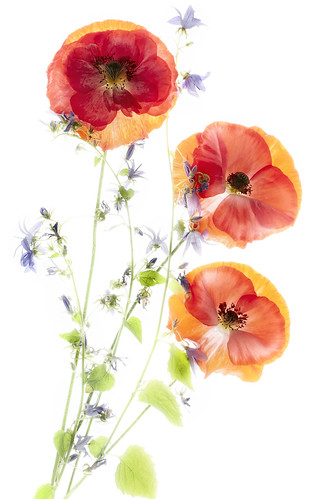
Papaver and Campanula, photo by Harold Davis. View this image larger.
This is an image of Papaver Rhoeas and Campanula—or, to use common names, Poppy and Bellflower—both kinds of flowers from my garden.
I place the flowers on a flourescent light box to create a back lit effect and photographed straight down. There’s very little light coming from the front of these flowers. To increase the transparent effect, I sprayed them with water, brushed the water around for even coverage, and pressed the ensemble gently down with a large piece of 1/2 inch plate glass. I removed the glass before taking the photos used to create this composite image.
My technique with this kind of transparent, high-key image is to bracket exposures, all of them biased to the over-exposed side. In this case, I used my Sigma 50mm macro lens. I set the aperture to f/11 and the ISO to 100. Then I made ten exposures, ranging in shutter speeds from 2 seconds to 1/50 of a second.
I started by processing the lightest and brightest exposure (the 2 second one) in Photoshop. Then I gradually layered in detail from the darker versions, using layers and the Paint Brush Tool in Photoshop.
The resulting composite produced the effect I was looking for: the transulence and brightness of a water color with light apparently shining through the partially transparent flowers.
stampmouse
26 Jun 2010wow this is gorgeous. the time and detail make it even more beautiful. thanks for sharing this
Pingback: Papaver and Campanula | Photoblog 2.0
Pingback: Creating Textured Backgrounds: Cherry Branch | Photoblog 2.0